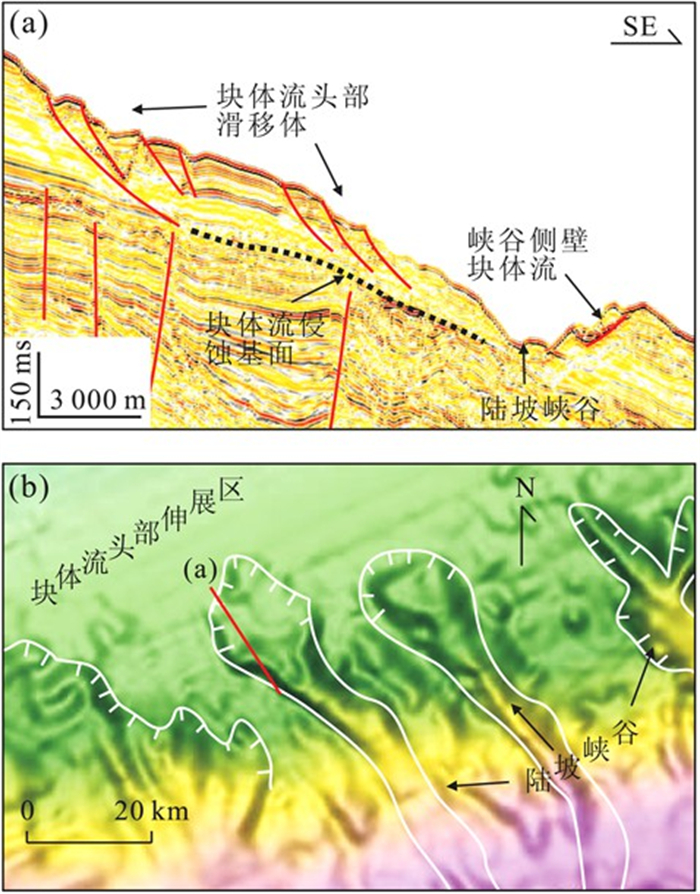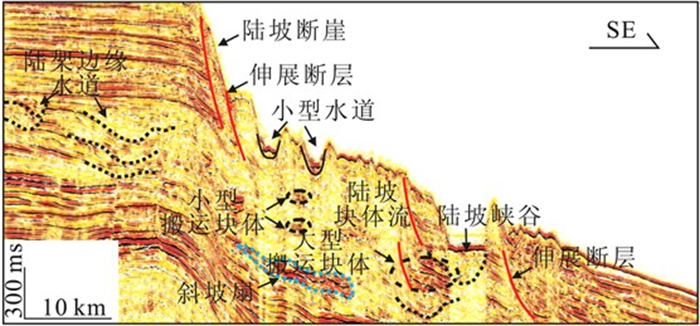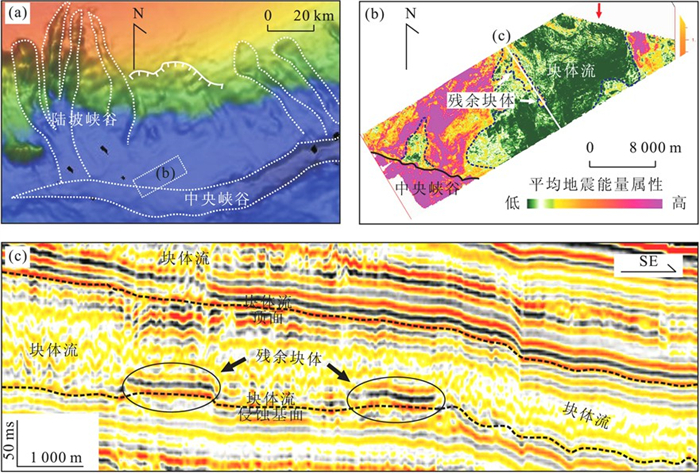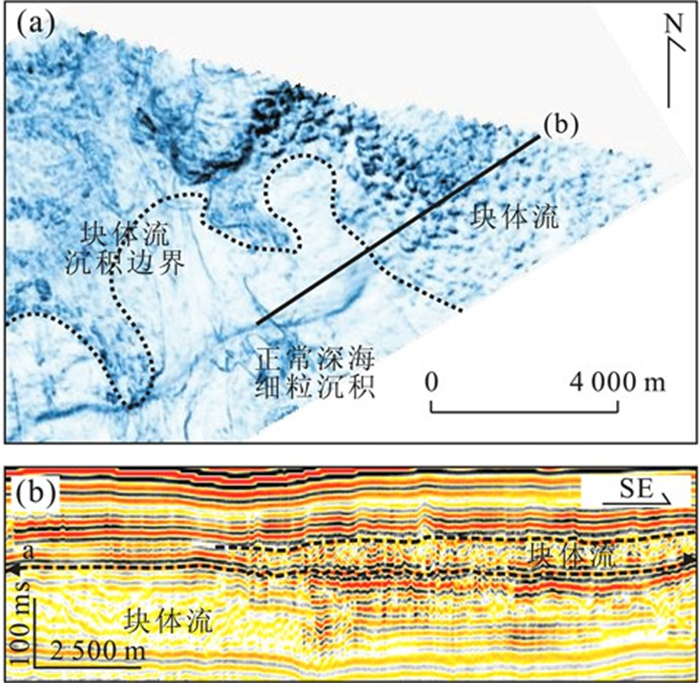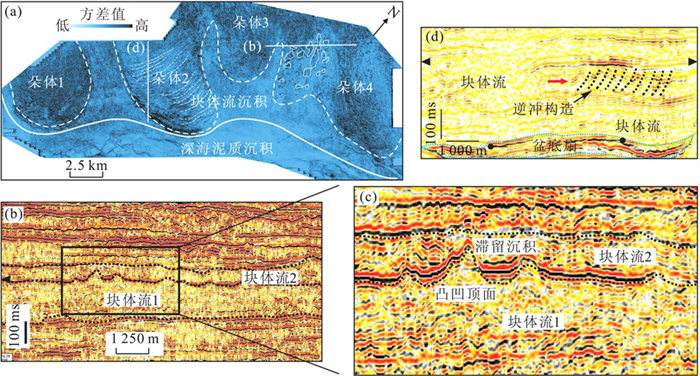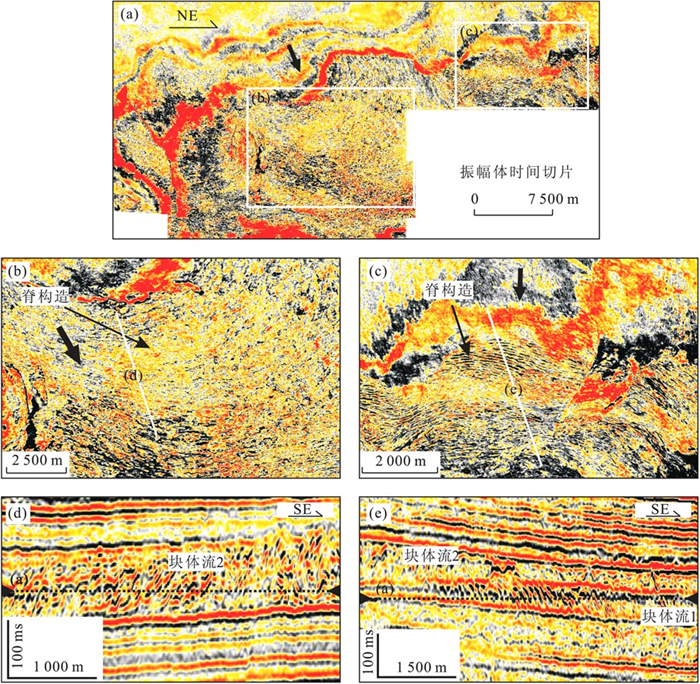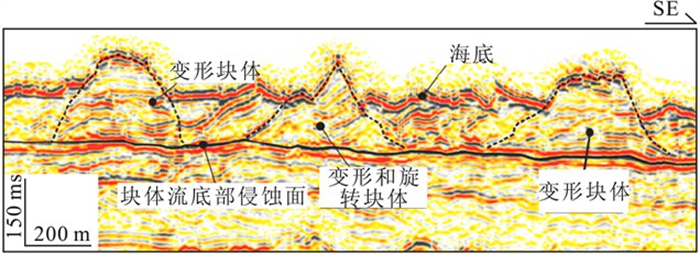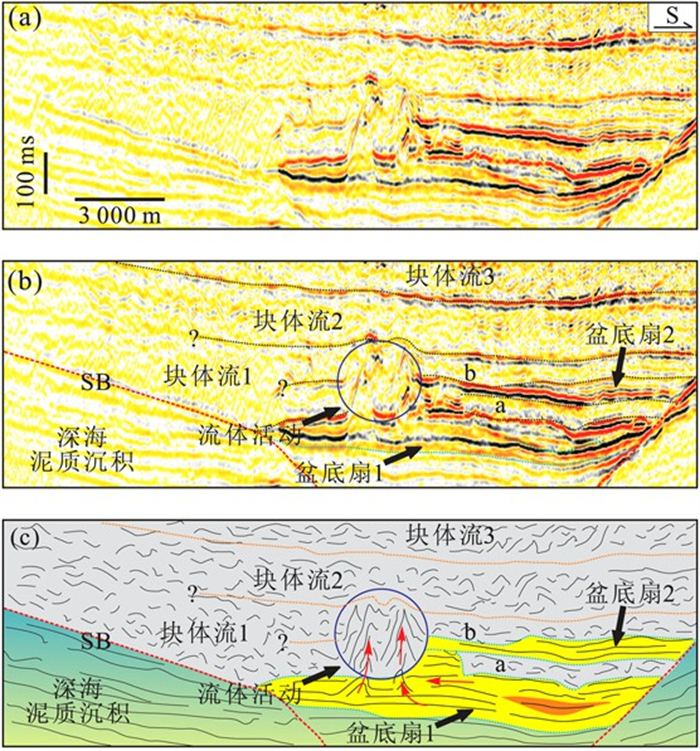Architecture and Characteristics of Mass Transport Deposits (MTDs) in Qiongdongnan Basin in Northern South China Sea
-
摘要: 为了深化对琼东南盆地深水区沉积体系的认识, 基于琼东南盆地深水区2D和3D地震资料, 发现琼东南盆地深水区发育大量的块体流沉积.通过对块体流沉积进行精细刻画, 识别出一些典型的块体流沉积特征: 滑移体、陆坡陡崖、搬运块体、残余块体、挤压脊、逆冲断层以及块体流顶部的滞留沉积等.陡倾陆坡上块体流以杂乱反射为特征, 地层变形剧烈, 而宽缓陆坡上块体流以发育地层变形微弱的滑移体为特征, 反映出陆坡角度对于块体流发育及其内部结构特征有明显的控制作用.大规模块体流沉积作为深海沉积的重要组成部分, 对于深海沉积物的空间展布具有重要的控制作用: 一方面, 通过不规则顶面影响随后沉积物的输送通道和沉积体的内部结构; 另一方面, 对已沉积的地层产生直接的侵蚀作用, 破坏原始沉积地层的内部结构, 造成潜在储层中地质流体的逸散.因此, 鉴于块体流对深水沉积体系重要的影响, 有必要加强对块体流沉积的精细研究, 以更好地指导深水油气勘探.Abstract: In order to understand the deepwater depositional system in Qiongdongnan basin better, this study interprets the deepwater depositional architectures based on the regional 2D and 3D seismic data and it is found that large-scale MTDs are well developed in Qiongdongnan basin.According to the detailed study on MTDs, typical elements have been identified such as slide, escarpment, transported blocks, remnant blocks, compression ridge, thrust fault and ponded depositon on the irregular top surface.The MTDs on the slope with steep angles are characterized by chaotic seismic facies with tense deformation, while those on the gentle-angle slope are characterized by the slide with less deformation, which indicates that the angle of the slope has obvious control effect on the development and internal architecture features of MTDs.Being regarded as an important part of deepwater deposition, MTDs have an important effect on the spatial distribution of sediment in deepwater.On the one hand, the irregular top surface of MTDs affects the distribution and internal architecture of succedent sediments; on the other hand, MTDs erodes the former strata directly and wrecks the internal structure of former strata.And also, the erosion can give rise to effusion of the fluid in potential reservoir.Hence, according to its important role in deepwater deposition system, it is necessary to further the elaborate study on the MTDs to make the deepwater exploration more efficiently.
-
图 5 块体流沉积趾部发育的超覆结构
a.块体流沉积方差体沿层切片图及其解释, 切片位置见图 5b; b.块体流趾部的超覆结构
Fig. 5. The onlap structure of MTDs in toe domain
图 8 挪威大陆边缘盆地块体流沉积表面特征(据Bull et al., 2009)
Fig. 8. The characteristics of top surface of MTDs in Norway passive margin
-
[1] Armitage, D. A., Stright, L., 2010. Modeling and interpreting the seismic-reflection expression of sandstone in an ancient mass-transport deposit dominated deep-water slope environment. Marine and Petroleum Geology, 27(1): 1-12. doi: 10.1016/j.marpetgeo.2009.08.013. [2] Binh, N. T. T., Tokunaga, T., Nakamura, T., et al., 2009. Physical properties of the shallow sediments in Late Pleistocene Formations, Ursa basin, gulf of Mexico, and their implications for generation and preservation of shallow overpressures. Marine and Petroleum Geology, 26(4): 474-486. doi: 10.1016/j.marpetgeo.2009.01.018. [3] Bryn, P., Berg, K., Forsberg, C. F., et al., 2005. Explainingthe Storegga slide. Marine and Petroleum Geology, 22(1-2): 11-19. doi: 10.1016/j.marpetgeo.2004.12.003. [4] Bull, S., Cartwright, J., Huuse, M., 2009. A review of kinematic indicators from mass-transport complexes using 3D seismic data. Marine and Petroleum Geology, 26(7): 1132-1151. doi: 10.1016/j.marpetgeo.2008.09.011. [5] Canals, M., Lastrasa, G., Urgelesa, R., et al., 2004. Slope failure dynamics and impacts from seafloor and shallow sub-seafloor geophysical data: case studies from the COSTA project. Marine Geology, 213(1-4): 9-72. doi: 10.1016/j.margeo.2004.10.001. [6] Casas, D., Ercilla, G., Baraza, J., et al., 2003. Recent massmovement processes on the Ebro continental slope(NW Mediterranean). Marine and Petroleum Geology, 20(5): 445-457. doi: 10.1016/S0264-8172(03)00078-3. [7] Dykstra, M., Kneller, B., Milana, J. P., 2006. Deglacial and postglacial sedimentary architecture in a deeply incised paleovalley: paleofjord-the Pennsylvanian(Late Carboniferous)Jejenes Formation, San Juan, Argentina. Geological Society of America Bulletin, 118(7-8): 913-937. doi: 10.1130/B25810.1. [8] Frey-Martinez, J., Cartwright, J., Hall, B., 2005.3D seismic interpretation of slump complexes: examples from the continental margin of Israel. Basin Research, 17(1): 83-108. doi: 10.1111/j.1365-2117.2005.00255.x. [9] Frey-Martinez, J., Cartwright, J., James, D., 2006. Frontally confined versus frontally emergent submarine landslides: a 3D seismic characterisation. Marine and Petroleum Geology, 23(5): 585-604. doi: 10.1016/j.marpetgeo.2006.04.002. [10] Gee, M. J. R., Gawthorpe, R. L., Friedmann, J. S., 2005. Giant striations at the base of a submarine landslide. Marine Geology, 214(1-3): 287-294. doi: 10.1016/j.margeo.2004.09.003. [11] Gee, M. J. R., Gawthorpe, R. L., Friedmann, S. J., 2006. Triggering and evolution of a giant submarine landslide, offshore Angola, revealed by 3D seismic stratigraphy and geomorphology. Journal of Sedimentary Research, 76(1): 9-19. doi: 10.2110/jsr.2006.02. [12] Gee, M. J. R., Uy, H. S., Warren, J., et al., 2007. The Brunei slide: agiant submarine landslide on the North West Borneo margin revealed by 3D seismic data. Marine Geology, 246(1): 9-23. doi: 10.1016/j.margeo.2007.07.009. [13] Gong, Z. S., 2004. Neotectonics and petroleum accumulation in offshore Chinese basins. Earth Science—Journal of China University of Geosciences, 29(5): 513-517 (in Chinese with English abstract). http://www.researchgate.net/publication/279545947_neotectonics_and_petroleum_accumulation_in_offshore_chinese_basins [14] He, J. X., Yan, W., Ma, W. H., et al., 2010. Analogy of oiland gas geology between quasi-passive margin of northern South China Sea and global oil and gas enriched areas in deep water. Natural Gas Geoscience, 21(6): 897-908, 995 (in Chinese with English abstract). http://en.cnki.com.cn/Article_en/CJFDTOTAL-TDKX201006005.htm [15] He, Y. L., Xie, X. N., Li, J. L., et al., 2010. Depositional characteristics and controlling factors of continental slope system in the Qiongdongnan basin. Geological Science and Technology Information, 29(2): 118-122 (in Chinese with English abstract). [16] Huvenne, V. A. I., Croker, P. F., Henriet, J. P., 2002. A refreshing 3D view of an ancient sediment collapse andslope failure. Terra Nova, 14(1): 33-40. doi: 10.1046/j.1365-3121.2002.00386.x. [17] Lewis, K. B., 1971. Slumping on a continental slope inclined at 1°-4°. Sedimentology, 16(1-2): 97-110. doi: 10.1111/j.1365-3091.1971.tb00221.x. [18] Li, C. G., Fan, F. X., Yan, J., 2007. The slipping zone in the north of the shelf break in the East China Sea. Marine Sciences, 31(5): 90-92 (in Chinese with English abstract). http://www.zhangqiaokeyan.com/academic-journal-cn_marine-sciences_thesis/0201253855484.html [19] Li, M. B., Jin, X. L., Li, J. B., et al., 2005. Miocene deposition and Palaeo-slope evolvement of the middle part of northern continental slope in the South China Sea. Acta Oceanologica Sinica, 27(3): 73-79 (in Chinese with English abstract). http://d.wanfangdata.com.cn/Periodical/hyxb200503010 [20] Li, Q. Y., Zheng, H. B., Zhong, G. F., et al., 2005. Tectonic events indicated by Late Oligocene slumped deposits from the South China Sea. Earth Science—Journal of China University of Geosciences, 30(1): 19-24 (in Chinese with English abstract). http://www.wanfangdata.com.cn/details/detail.do?_type=perio&id=dqkx200501002 [21] Liu, B. H., Li, X. S., Zhao, Y. X., et al., 2005. Debris transport on the western continental slope of the Okinawa trough: slumping and gravity flowing. Oceanologia et Limnologia Sinica, 36(1): 1-9 (in Chinese with English abstract). http://d.wanfangdata.com.cn/Periodical/hyyhz200501001 [22] Locat, J., Lee, H., 2009. Submarine mass movements and their consequences: an overview. In: Sassa, K., Canuti, P., eds., Landslides-disaster risk reduction. Springer Verlag, Berlin, 115-142. [23] Micallef, A., Masson, D. G., Berndt, C., et al., 2009. Development and mass movement processes of the north-eastern Storegga slide. Quaternary Science Reviews, 28(5-6): 433-448. doi: 10.1016/j.quascirev.2008.09.026. [24] Moscardelli, L., Wood, L., Mann, P., 2006. Mass-transport complexes and associated processes in the offshore area of Trinidad and Venezuela. AAPG Bulletin, 90: 1059-1088. doi: 10.1306/02210605052. [25] Owen, M., Day, S., Maslin, M., 2007. Late Pleistocene submarine mass movements: occurrence and causes. Quaternary Science Reviews, 26(7-8): 958-978. doi: 10.1016/j.quascirev.2006.12.011. [26] Pickering, K. T., Corregidor, J., 2005. Mass-transport complexes, (MTCs)and tectonic control on basin-floor submarine fans, Middle Eocene, South Spanish Pyrenees. Journal of Sedimentary Research, 75(5): 761-783. doi: 10.2110/jsr.2005.062. [27] Posamentier, H. W., Kolla, V., 2003. Seismic geomorphology and stratigraphy of depositional elements in deep-watersettings. Journal of Sedimentary Research, 73(3): 367-388. doi: 10.1306/111302730367. [28] Ren, J. Y., L, S. T., 2000. Spreading and dynamic setting of marginal basins of the western Pacific. Earth Science Frontiers, 7(3): 203-213 (in Chinese with English abstract). http://www.researchgate.net/publication/305387234_Spreading_and_dynamic_setting_of_marginal_basins_of_the_western_Pacific [29] Sangree, J. B., Widmier, J. M., 1978. Seismic stratigraphy and global changes of sea-level, part 9: seismic interpretation of clastic depositional facies. American Association of Petroleum Geologists, 62(5): 752-771. [30] Shao, L., Pang, X., Zhang, G. C., et al., 2009. Late Oligocene tectonic event in the northern South China Sea and its implications. Earth Science—Journal of China University of Geosciences, 34(5): 717-724 (in Chinese with English abstract). doi: 10.3799/dqkx.2009.079 [31] Silva, A. J., Baxter, C. D. P., LaRosa, P. T., et al., 2004. Investigation of mass wasting on the continental slope and rise. Marine Geology, 203(3-4): 355-366. doi: 10.1016/S0025-3227(03)00315-3. [32] Strachan, L. J., 2002. Slump-initiated and controlled syndepositional sandstone remobilization: an example from the Namurian of County Clare, Ireland. Sedimentology, 49(1): 25-41. doi: 10.1046/j.1365-3091.2002.00430.x. [33] Stevenson, C. J., Peakall, J., 2010. Effects of topography on lofting gravity flows: implications for the deposition of deep-water massive sands. Marine and Petroleum Geology, 27: 1366-1378. doi: 10.1016/j.marpetgeo.2010.03.010 [34] Sun, Z., Sun, L. T., Zhou, D., et al., 2009. Discussion on the South China Sea evolution and lithospheric breakup through 3D analogue modeling. Earth Science—Journal of China University of Geosciences, 34(3): 435-447 (in Chinese with English abstract). doi: 10.3799/dqkx.2009.049 [35] Vanneste, M., Mienert, J., Bunz, S., 2006. The Hinlopen slide: agiant, submarine slope failure on the northern Svalbard margin, Arctic Ocean. Earth and Planetary Science Letters, 245(1-2): 373-388. doi: 10.1016/j.epsl.2006.02.045. [36] Wang, D. W., Wu, S. G., Qing, Z. L., et al., 2009. Architecture and identification of large Quaternary mass transport depositions in the slope of South China Sea. Marine Geology and Quaternary Geology, 29(5): 65-72 (in Chinese with English abstract). http://en.cnki.com.cn/Article_en/CJFDTOTAL-HYDZ200905014.htm [37] Wang, H. R., Wang, Y. M., Qiu, Y., et al., 2008. Geomorphology and its control of deep-water slope of the margin of the South China Sea. Acta Oceanologica Sinica, 30(2): 70-79 (in Chinese with English abstract). http://www.cnki.com.cn/Article/CJFDTotal-SEAC200802009.htm [38] Wang, P. X., Jian, Z. M., Zhao, Q. H., et al., 2003. Evolution of the South China Sea and monsoon history revealed in deep sea records. Chinese Science Bulletin, 48(23): 2549-2561. doi: 10.1360/03wd0156. [39] Wu, S. G., Qin, Y. S., 2009. The research of deepwater depositional system in the northern South China Sea. Acta Sedimentologica Sinica, 27(5): 922-930 (in Chinese with English abstract). http://d.wanfangdata.com.cn/periodical/cjxb200905016 [40] Xie, X. N., Müller, R. D., Ren, J. Y., et al., 2008. Stratigraphic architecture and evolution of the continental slope system in offshore Hainan, northern South China Sea. Marine Geology, 247(3-4): 129-144. doi: 10.1016/j.margeo.2007.08.005. [41] Yao, B. C., 1996. Tectonic evolution of the South China Sea in Cenozoic. Marine Geology and Quaternary Geology, 16(2): 1-13 (in Chinese with English abstract). [42] Zhu, W. L., Zhang, G. C., Zhong, K., et al., 2010. South China Sea: oil and gas outlook. Engineering Sciences, 12(5): 46-50 (in Chinese with English abstract). http://en.cnki.com.cn/Article_en/CJFDTOTAL-GCKX201005007.htm [43] 龚再升, 2004. 中国近海含油气盆地新构造运动与油气成藏. 地球科学——中国地质大学学报, 29(5): 513-517. https://www.cnki.com.cn/Article/CJFDTOTAL-DQKX200405001.htm [44] 何家雄, 颜文, 马文宏, 等, 2010. 南海北部准被动陆缘深水区油气地质及与世界深水油气富集区类比. 天然气地球科学, 21(6): 897-908, 995. https://www.cnki.com.cn/Article/CJFDTOTAL-TDKX201006005.htm [45] 何云龙, 解习农, 李俊良, 等, 2010. 琼东南盆地陆坡体系发育特征及其控制因素. 地质科技情报, 29(2): 118-122. doi: 10.3969/j.issn.1000-7849.2010.02.020 [46] 李成钢, 范奉鑫, 阎军, 2007. 东海陆架前缘斜坡北部的滑塌带. 海洋科学, 31(5): 90-92. doi: 10.3969/j.issn.1000-3096.2007.05.017 [47] 黎明碧, 金翔龙, 李家彪, 等, 2005. 南海中北部中新世陆坡凹陷沉积充填与古陆坡形态演变. 海洋学报(中文版), 27(3): 73-79. doi: 10.3321/j.issn:0253-4193.2005.03.010 [48] 李前裕, 郑洪波, 钟广法, 等, 2005. 南海晚渐新世滑塌沉积指示的地质构造事件. 地球科学——中国地质大学学报, 30(1): 19-24. https://www.cnki.com.cn/Article/CJFDTOTAL-DQKX200501001.htm [49] 刘保华, 李西双, 赵月霞, 等, 2005. 冲绳海槽西部陆坡碎屑沉积物的搬运方式: 滑塌和重力流. 海洋与湖沼, 36(1): 1-9. doi: 10.3321/j.issn:0029-814X.2005.01.001 [50] 任建业, 李思田, 2000. 西太平洋边缘海盆地的扩张过程和动力学背景. 地学前缘, 7(3): 203-213. doi: 10.3321/j.issn:1005-2321.2000.03.019 [51] 邵磊, 庞雄, 张功成, 等, 2009. 南海北部渐新世末的构造事件. 地球科学——中国地质大学学报, 34(5): 717724. https://www.cnki.com.cn/Article/CJFDTOTAL-DQKX200905003.htm [52] 孙珍, 孙龙涛, 周蒂, 等, 2009. 南海岩石圈破裂方式与扩张过程的三维物理模拟. 地球科学——中国地质大学学报, 34(3): 435-447. https://www.cnki.com.cn/Article/CJFDTOTAL-DQKX200903008.htm [53] 王大伟, 吴时国, 秦志亮, 等, 2009. 南海陆坡大型块体搬运体系的结构与识别特征. 海洋地质与第四纪地质, 29(5): 65-72. https://www.cnki.com.cn/Article/CJFDTOTAL-HYDZ200905014.htm [54] 王海荣, 王英民, 邱燕, 等, 2008. 南海北部陆坡的地貌形态及其控制因素. 海洋学报(中文版), 30(2): 70-79. doi: 10.3321/j.issn:0253-4193.2008.02.009 [55] 汪品先, 翦知湣, 赵泉鸿, 等, 2003. 南海演变与季风历史的深海证据. 科学通报, 48(21): 2228-2239. doi: 10.3321/j.issn:0023-074X.2003.21.005 [56] 吴时国, 秦蕴珊, 2009. 南海北部陆坡深水沉积体系研究. 沉积学报, 27(5): 922-930. https://www.cnki.com.cn/Article/CJFDTOTAL-CJXB200905017.htm [57] 姚伯初, 1996. 南海海盆新生代的构造演化史. 海洋地质与第四纪地质, 16(2): 1-13. https://www.cnki.com.cn/Article/CJFDTOTAL-HYDZ602.000.htm [58] 朱伟林, 张功成, 钟锴, 等, 2010. 中国南海油气资源前景. 中国工程科学, (5): 46-50. https://www.cnki.com.cn/Article/CJFDTOTAL-GCKG202002016.htm -









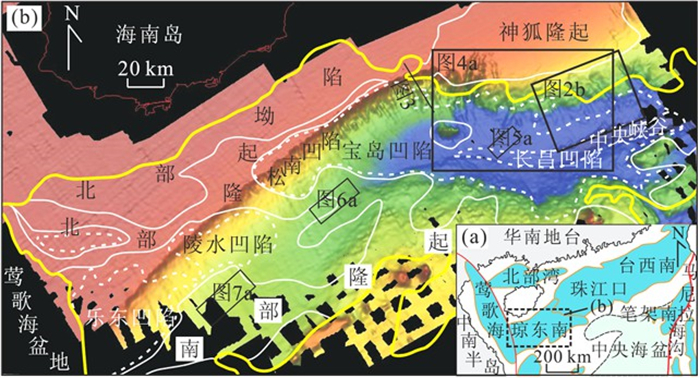
 下载:
下载:
